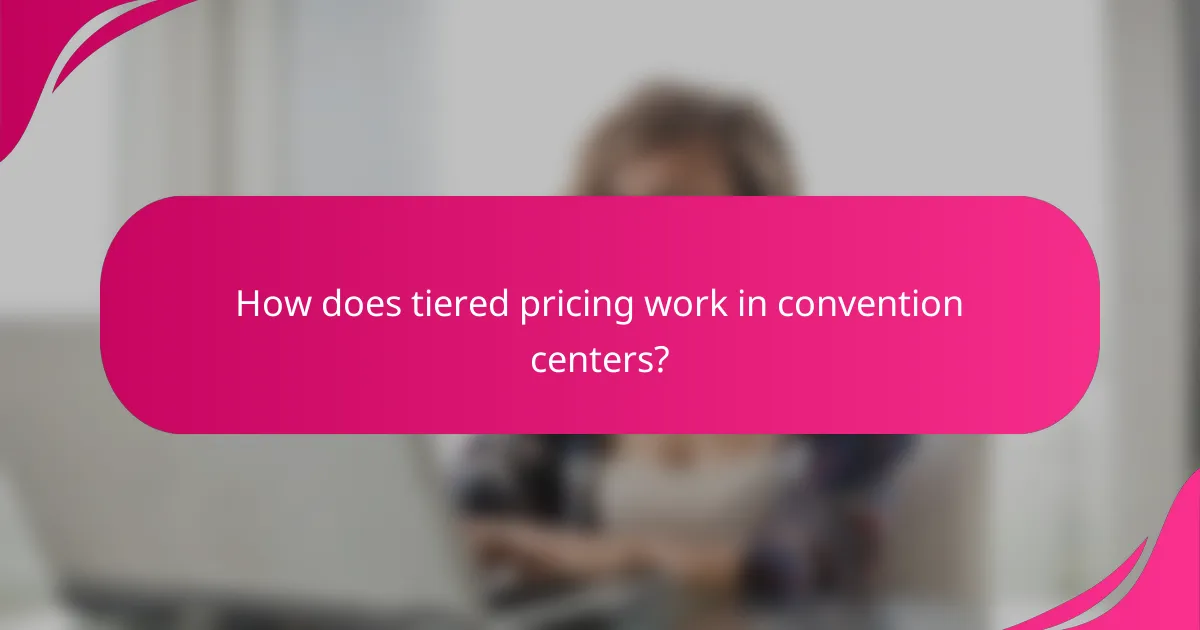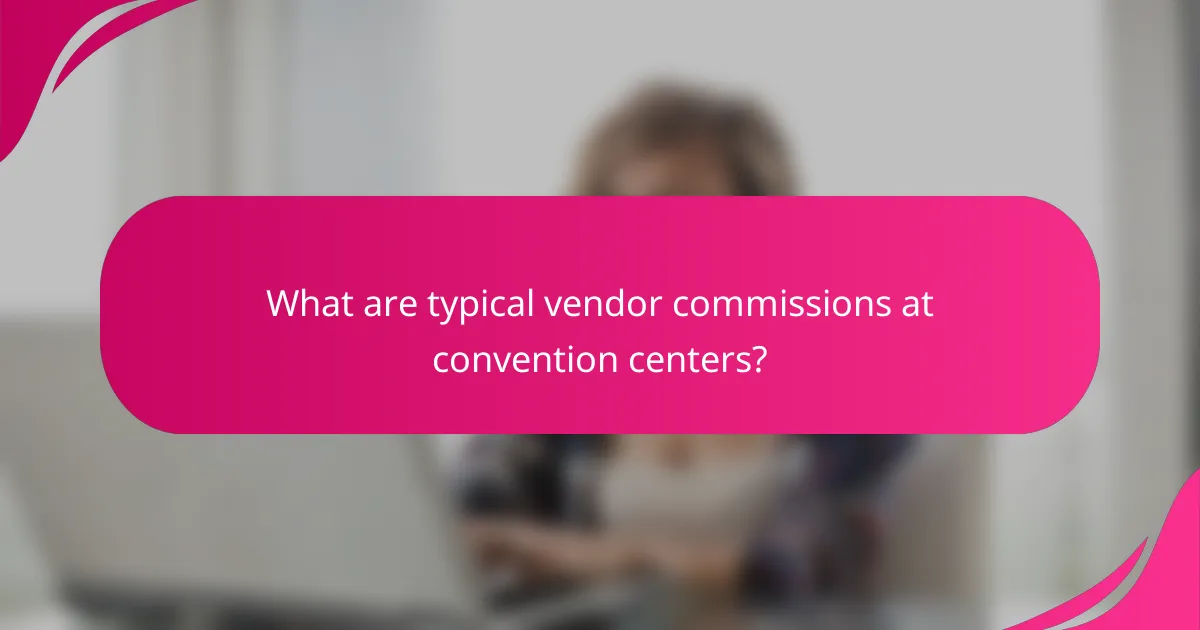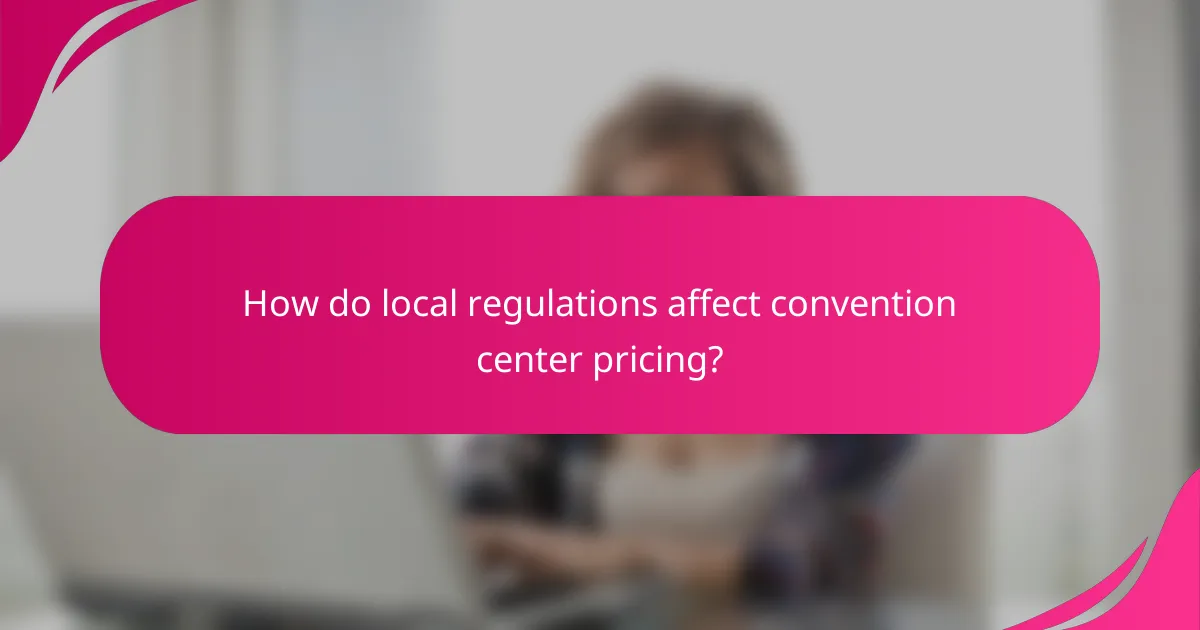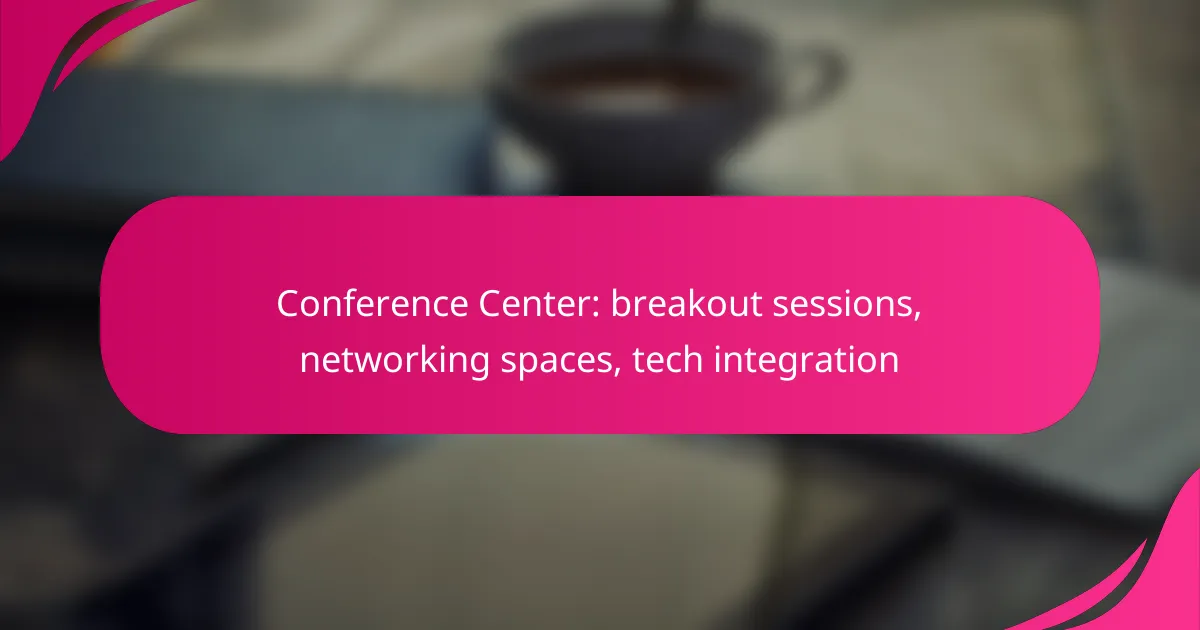Convention centers utilize tiered pricing strategies to accommodate various event sizes and booking timelines, enabling organizers to select options that align with their financial plans. Additionally, vendor commissions, typically ranging from 10% to 30%, play a significant role in the financial dynamics of these venues. Understanding logistical costs, which include transportation, equipment rental, and staffing, is essential for effective budget management when planning events.

How does tiered pricing work in convention centers?
Tiered pricing in convention centers is a pricing strategy that offers different price levels based on various factors such as the size of the event, the time of booking, or the services included. This approach allows organizers to choose a pricing tier that best fits their budget and needs while maximizing the venue’s revenue potential.
Definition of tiered pricing
Tiered pricing is a structured pricing model that divides costs into different levels or tiers, each with its own price point. In the context of convention centers, these tiers can be based on factors like the number of attendees, the duration of the event, or the amenities provided. This model helps to accommodate a range of budgets and event types.
Benefits of tiered pricing
One of the primary benefits of tiered pricing is its flexibility, allowing event organizers to select a package that aligns with their specific requirements and financial constraints. Additionally, this model can help convention centers optimize their revenue by attracting a broader range of clients, from small meetings to large conferences.
Another advantage is the potential for increased customer satisfaction, as clients can choose a tier that offers the right balance of services and costs. This can lead to repeat business and positive word-of-mouth referrals, which are crucial for the venue’s reputation.
Examples of tiered pricing models
Common examples of tiered pricing models in convention centers include basic, standard, and premium packages. A basic package might include the rental of the space and basic AV equipment, while a standard package could add catering services and additional technical support. The premium package might offer full-service event planning and exclusive access to high-demand facilities.
Another model could involve early bird pricing, where clients receive a discount for booking several months in advance, while last-minute bookings incur higher rates. This encourages early commitments and helps the venue manage its calendar effectively.

What are typical vendor commissions at convention centers?
Vendor commissions at convention centers generally range from 10% to 30% of sales, depending on the type of event and the specific agreements made. These commissions are a crucial part of the financial structure for vendors operating within these venues.
Standard commission rates
Standard commission rates for vendors at convention centers typically fall between 15% and 20% of gross sales. However, rates can vary widely based on the event’s scale, the vendor’s product type, and the center’s policies. For example, food and beverage vendors may face higher commissions compared to merchandise sellers.
Some convention centers may also offer tiered pricing structures where the commission percentage decreases as sales volume increases. This incentivizes vendors to boost their sales, benefiting both parties.
Factors influencing vendor commissions
Several factors can influence vendor commissions at convention centers, including the type of event, expected foot traffic, and the duration of the event. High-profile events with large audiences may command higher commission rates due to increased sales potential.
Additionally, the level of competition among vendors can impact commission structures. If multiple vendors offer similar products, centers may adjust commissions to attract and retain quality vendors. It’s essential for vendors to negotiate terms that reflect their unique offerings and the expected audience engagement.

What logistical costs should be considered?
Logistical costs encompass a range of expenses associated with organizing and executing events at a convention center. Key considerations include transportation, equipment rental, staffing, and utilities, all of which can significantly impact the overall budget.
Common logistical expenses
Common logistical expenses for events typically include venue rental fees, which can vary widely based on location and size, often ranging from hundreds to thousands of dollars. Additionally, transportation costs for moving equipment and materials to and from the venue can add up, especially if long distances are involved.
Other significant expenses include equipment rental for audiovisual needs, furniture, and staging, as well as staffing costs for security, catering, and event management. Utilities such as electricity, water, and internet access are also crucial to factor in, as these can incur additional charges based on usage.
Cost-saving strategies
To manage logistical costs effectively, consider negotiating with vendors for better rates or package deals that combine multiple services. Booking the venue during off-peak times can also lead to substantial savings, as many convention centers offer lower rates during weekdays or non-peak seasons.
Utilizing local suppliers for equipment and services can reduce transportation costs and streamline logistics. Additionally, creating a detailed budget and tracking expenses throughout the planning process can help identify areas where costs can be minimized without sacrificing quality.

How to choose the right convention center?
Choosing the right convention center involves evaluating factors such as location, capacity, amenities, and pricing structures. Understanding these elements will help ensure your event runs smoothly and meets your budgetary requirements.
Key selection criteria
When selecting a convention center, consider the venue’s capacity to accommodate your expected number of attendees. Look for centers that offer flexible space configurations, as this can enhance the event experience. Additionally, assess the availability of necessary amenities, such as audio-visual equipment, catering services, and parking options.
Pricing structures are also crucial. Many convention centers utilize tiered pricing based on the size of the event, duration, and time of year. Be sure to inquire about vendor commissions and any logistical costs that may arise, as these can significantly impact your overall budget.
Comparative analysis of major venues
When comparing major convention centers, it’s beneficial to create a checklist of essential features. For instance, look at the square footage, number of breakout rooms, and accessibility for attendees. Some venues may offer lower base rental fees but higher costs for additional services, while others might provide comprehensive packages that include everything you need.
Consider local options as well. For example, in cities like Chicago or Las Vegas, you may find a range of venues from large, well-known centers to smaller, boutique spaces. Each will have different pricing tiers and commission structures, so it’s wise to compare these factors side by side to find the best fit for your event’s needs.

What are the implications of pricing structures on event planning?
Pricing structures significantly impact event planning by determining how budgets are allocated and influencing vendor choices. Understanding these implications helps in making informed decisions that align with financial goals and event objectives.
Impact on budget allocation
Pricing structures, such as tiered pricing or flat fees, dictate how much of the overall budget will be spent on venue costs versus other expenses. For instance, a venue with a tiered pricing model may offer lower rates for off-peak times, allowing planners to allocate more funds to marketing or entertainment.
When planning, consider the total costs associated with each pricing structure, including hidden fees or commissions. Creating a detailed budget breakdown can help identify areas where savings can be made, ensuring that funds are effectively distributed across all event needs.
Influence on vendor selection
The pricing structure of a convention center can directly affect which vendors are selected for an event. For example, if a venue charges high commissions on vendor sales, it may discourage certain suppliers from participating, limiting options for catering, audiovisual services, or decor.
Event planners should evaluate vendor agreements in the context of the venue’s pricing model. Comparing vendor costs and commissions can reveal potential partnerships that offer better value, helping to enhance the overall event experience while staying within budget.

How do local regulations affect convention center pricing?
Local regulations significantly influence convention center pricing by establishing standards for safety, accessibility, and operational practices. These regulations can lead to varying costs for compliance, which are often passed on to vendors and event organizers.
Overview of regulations in the UK
In the UK, convention centers must adhere to various regulations, including the Health and Safety at Work Act and the Equality Act. These laws ensure that venues are safe for all attendees and accessible to individuals with disabilities. Compliance with these regulations can affect venue capacity, layout, and overall pricing structures.
Local councils may also impose additional requirements, such as noise restrictions or permits for large gatherings, which can further impact costs. Understanding these regulations is crucial for event planners to avoid penalties and ensure a smooth event.
Compliance costs
Compliance costs for convention centers can vary widely based on the specific regulations in place. Costs may include safety inspections, accessibility modifications, and staff training, which can collectively represent a significant portion of the overall operational budget. For instance, venues might spend anywhere from a few thousand to tens of thousands of GBP annually on compliance-related expenses.
Event organizers should factor these compliance costs into their budgets when planning events. It’s advisable to consult with the venue management early in the planning process to understand all potential fees and requirements, ensuring that there are no unexpected financial burdens later on.

What emerging trends are shaping convention center pricing?
Convention center pricing is increasingly influenced by tiered pricing models, vendor commissions, and logistical costs. These trends reflect the evolving landscape of event management, where flexibility and transparency are becoming essential for both organizers and venues.
Tiered pricing models
Tiered pricing models allow convention centers to offer different rates based on factors such as event size, duration, and season. This approach helps venues maximize occupancy while providing organizers with options that fit their budgets. For instance, smaller events might receive discounts during off-peak times, while larger gatherings could benefit from package deals that include additional services.
When considering tiered pricing, organizers should evaluate their specific needs and the potential for cost savings. Comparing rates across multiple venues can reveal significant differences, particularly during peak seasons when demand is high. It’s advisable to inquire about any hidden fees that may apply to different tiers.
Vendor commissions
Vendor commissions are becoming a standard practice in convention centers, where venues take a percentage of sales from third-party vendors. This can include catering, audiovisual services, and equipment rentals. Understanding these commissions is crucial for event planners, as they can impact overall event budgets.
Typically, vendor commissions range from 15% to 30%, depending on the service and venue. Organizers should negotiate these terms upfront and consider the total cost of services when budgeting. Opting for in-house vendors may reduce commission fees, but it’s essential to weigh the quality and flexibility of services offered.
Logistical costs
Logistical costs encompass a variety of expenses associated with hosting an event at a convention center, including setup, teardown, and transportation. These costs can vary widely based on the complexity of the event and the location of the venue. For example, a large trade show may incur higher logistical costs due to the need for extensive equipment and staffing.
To manage logistical costs effectively, planners should create a detailed budget that includes all potential expenses. It’s beneficial to work closely with venue staff to identify cost-saving opportunities, such as shared resources or bundled services. Additionally, early planning can help secure better rates for transportation and equipment rentals, ultimately reducing overall costs.



